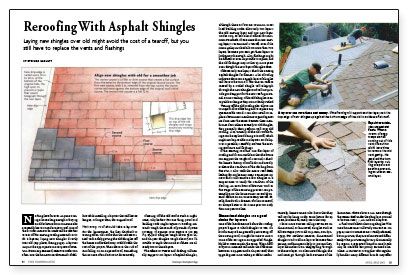Reroofing With Asphalt Shingles
Laying new shingles over old might avoid the cost of a tearoff, but you still have to replace the vents and flashings.

Synopsis: This article shows how to install new asphalt roof shingles neatly without removing the underyling layer of old shingles. Details include the installation of flashing for a waste vent, chimney, roof valleys, and the intersection of roof and wall.
Nothing lasts forever. Anyone owning a house long enough or buying an older house from someone else eventually has to consider a new roof. One of the first decisions to be made will be whether to tear off the existing roofing materials or to do a layover, laying new shingles directly over old. A layover may not be appropriate in every reroof situation. But an experienced, attentive roofer can often save the homeowner thousands of dollars while installing a layover that will last as long as, or longer than, the original roof.
Not every roof should take a layover
For the homeowner, the first drawback to tearing off an old roof is that the risk associated with safely getting the old shingles off the house and hauled away could double the cost of the project. Then there is the risk of rain falling on an exposed roof, something that novices often don’t consider seriously.
If tearing off the old roof is such a nightmare, why bother? For one thing, your local building code might require it. Roofing materials weigh thousands of pounds. If you’re covering 15 squares (one square is 100 sq. ft.), 25-year shingles weigh about 3500 lb., and 40-year shingles weigh about 5000 lb. Double or triple that number if there are already two or three layers.
The rafters or trusses and decking will usually support two layers of asphalt shingles, although three or four are common. Most local building codes allow only two layers: the old existing layer and one new layer. Codes vary, so ask a local official for minimum standards. If I see more than one existing layer, I recommend a tearoff, even if the municipality involved allows more than two layers, because you can’t get three layers to look smooth enough. Also, flashings might be difficult or even impossible to replace; and the old flashings may not last 25 more years even though the new layer of shingles does.
If there’s only one layer, I check the existing asphalt shingles for flatness. A lot of curling indicates that even a single layer of shingles will have to be torn off. The uneven surface caused by a curled shingle will telegraph through the new shingles and will not provide good support for the new roofing material. Some cracking of the old shingles is acceptable as long as they are not badly curled.
Tearing off the old roofing also allows me to inspect all roof decking and to replace any questionable wood. I can also install or replace a bituminous membrane to guard against ice dams near the eaves. Because these membranes don’t adhere securely to old shingles, they generally don’t perform well over old roofing. Also, virtually all the old roof flashings can be replaced during a tearoff, which might not be possible in a layover. So if a layover is possible, I carefully evaluate the existing roof vents and flashings.
For more photos, illustrations, and details, click the View PDF button below:
Fine Homebuilding Recommended Products
Fine Homebuilding receives a commission for items purchased through links on this site, including Amazon Associates and other affiliate advertising programs.

Fall Protection

Flashing Boot Repair

Flashing Boot


























